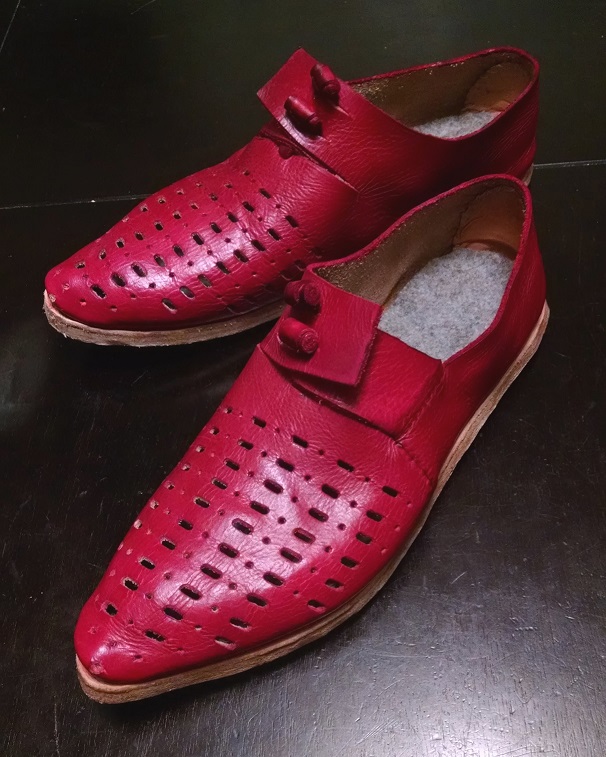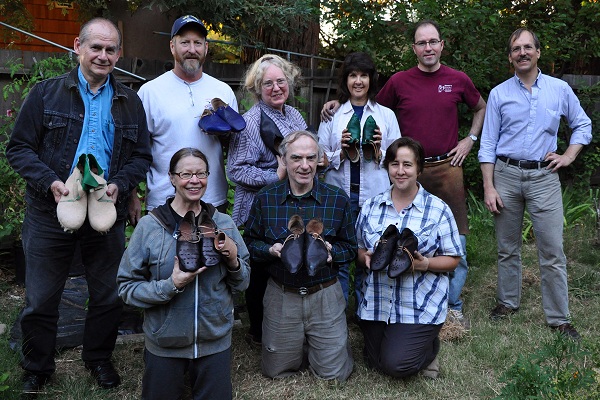A new pair for the fantastic Miss Jessie L – it’s always a good feeling when a pair of shoes fits properly. I hope I don’t jinx myself for the next few pairs! Although the punchwork pattern is typical 14th century, the sole construction is certainly much later while the toggles tend to be a bit earlier. I really like the look of double-toggles, though, and a double-sole is much more comfortable for feet that are used to a more rigid and/or cushioned ride, so to say. I figure that since I’m putting in the extra effort to add a welt, might as well attach something to it to make it more comfortable, not to mention the thick wool felt pasted in. Looking at these now, I do hope that one day, I’ll start getting my act together to making more period lasts.
Tag Archives: 14th C
14th C. Hinged Pattens
Pattens often had some kind of decoration or slashing on the straps and vamp closure. I’m delighted with the texture and flair that they give to otherwise utilitarian piece of footwear. The decorative oxide nails also are a nice touch, and contrast well with the light colored maple and vegetable tanned leather. I hope that Lisa will enjoy!
Caldarium Turn-Shoe Workshop
Matt L. and I ended up spending a weekend up in Marin helping seven people put together some turn shoes, and I have to say that I’m very pleased with the results. Every one of them worked hard with bristle and thread to come up with a pair of handmade shoes all their own. As always, there were a few things that did not work quite so well, and if I don’t mention those, we will make the same mistakes!
– The black dye can go on just fine with a few coats. We don’t need to blacken the lasts, our fingers, and everything else by overdoing it!
– We need to be very careful when tapping the inseam flat. Otherwise, you might hurt the upper leather and damage it.
– Always leave more heel than you think you need! The last thing you want is a heel that is too short.
– We were able to work the leather wet without any ill effects – this is useful when you’re trying to make a pair of shoes in a single weekend!
1350s Shoes from Fischmarkt
This pair is based on a 1350s extant piece documented in “Archeological Footwear” authored by Dr. Marquita Volken. The pattern comes from an unusual extant shoe which has an oval cutout on the inside of the shoe, along with a buckle strap to close the shoe around the foot. This shoe also has a binding strip all the way around the shoe including the strap, and is quite a pretty example of a medieval shoe. A few points of note – the original has the buckling on the inside of the shoe (it is easier to buckle your shoe this way while sitting down or standing up), but it unfortunately hides the pretty cutout and the buckle. As a result, the recipient asked that the buckle be placed on the lateral (outside) of the foot, rather than the medial side. Further, you will notice a rather thick sole – this was constructed as a turn-welt shoe, even though that particular style doesn’t really start to come about until the third quarter of the 15th century. I took several cues from Dr. Volken’s book in the construction of this pair, and I’m particularly pleased with the way they worked out. The decoration is inspired by several extant 14th century pieces with lines of decoration across the vamp of the shoe.
Let me share some of the techniques that I tried, starting with the binding strip. Although I’d done binding strips in the past, this was the first time that I’d done it in this manner.
Continue reading 1350s Shoes from Fischmarkt



